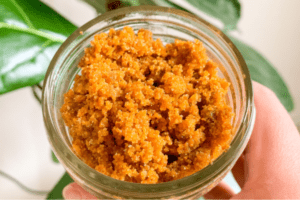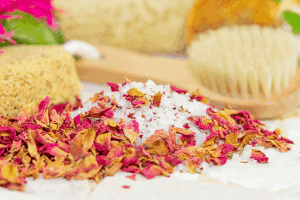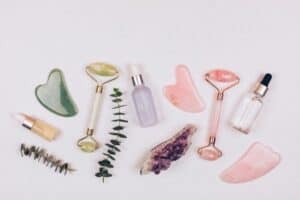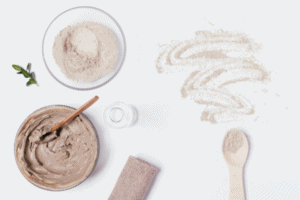Quick Guide to Starting an All-Natural Skin Care Routine for Beginners
Here’s a no-B.S. guide to creating an all-natural skin care routine for beginners based on your skin type!
If you’re new to skin care or want to revamp your routine, I’m so happy you’re here! Skin care can seem like this super-intense process with products you don’t really need.
It doesn’t have to be! We’re going to create your ultimate natural skin care routine and tailor it to what your skin really needs.
I’m going to teach you about all the basics you need to have every single day, and how to simplify it as much as possible.
And we’re going the natural route, which means your sensitive skin will finally be happy! But what do you actually need?
This post contains affiliate links. You can learn more here.
Pin this image for later!
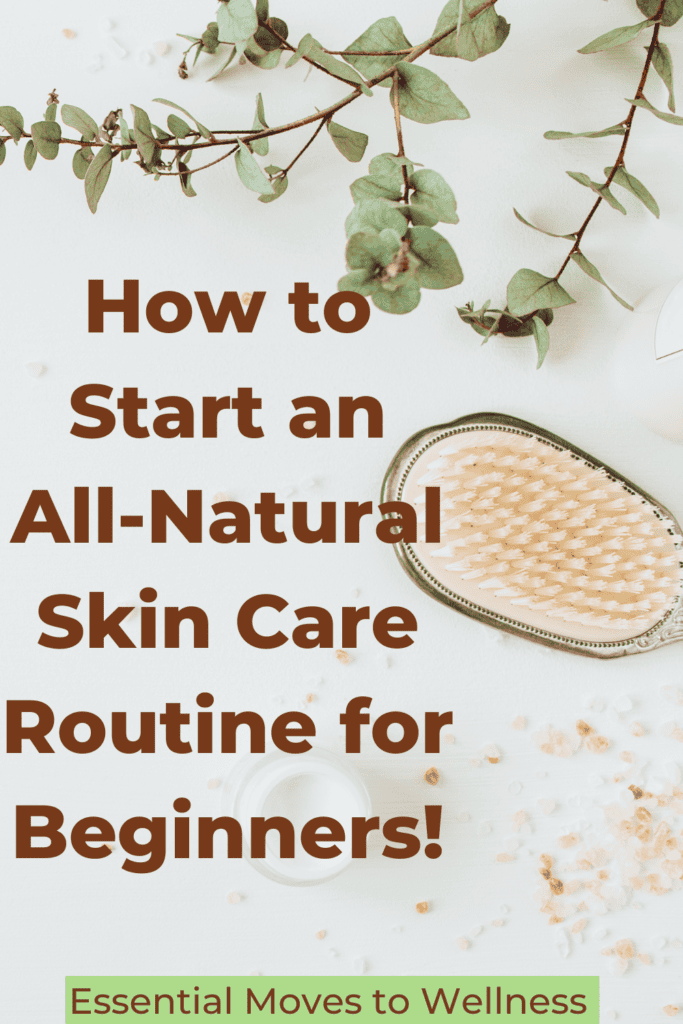
What Makes a Natural Skin Care Routine “Natural?”
While there’s no set or regulated definition of “natural” or “clean,” I think we can all agree that a natural skin care routine consists of products that only use ingredients derived from nature with no harmful or questionable substances.
What exactly those harmful ingredients are is a bit more complicated. Because there are little to no regulations within the cosmetics industry, clean beauty and natural skin care tends to be more of a spectrum rather than a set black-and-white rule.
What an all-natural skin care routine looks like to you may not look that way to me, and that’s totally okay! I call clean beauty a journey because our viewpoints on ingredient lists can change over time.
You can have your own natural skin care routine be as pure as you want! I personally am very strict with my ingredient lists for multiple reasons, but once you do your own research and form your own opinions, you’ll create your own clean beauty standards as well.
And Essential Moves to Wellness is a great place to start when it comes to clean beauty education!
Just start with gradually switching out your products as they run out with better, safer options. If you don’t know what a safer option looks like, keep reading! Or you can check out my guide to greenwashing, a sleazy marketing tactic everyone should know about.
My #1 Hack For a Flawless Routine
If you take nothing else from this article, remember this: The best daily skin care routine for glowing skin uses non-toxic products in order from least to most heavy.
And there should be a good amount of both water and oil-based products! I know that water and oil don’t mix, but you need both to create an effective skin care routine at home.
You need to start with water-based products because they are lighter and therefore penetrate your skin’s barrier much better than oil. But water also tends to evaporate quickly.
So then you put on your lotions and oils as a way to lock all that good water into place while it sits on top of your skin as a kind of nutrient-dense barrier.
Oil doesn’t absorb into your skin as deeply as water, but it provides a good amount of protection! That’s why I’m going to have you put most oils or creams on your face towards the end of your skin care routine.
Here’s a real-life example:
If you put your toner on after your serum, then the toner will either sit on top of your skin with the serum or evaporate away. It won’t be able to penetrate your skin’s top layer at all because it can’t get through the barrier created by your serum!
Now that we have an understanding of using lightest to heaviest natural skin care products, let’s get into which product you actually need! And don’t worry, you don’t need a 10-step routine (Unless that’s your jam, then by all means!).
In fact, I usually combine a couple of these products to make my life easier. It also creates an incredibly affordable skin care routine that you can work into any budget. But pay attention to the order of them! That’s what really counts.
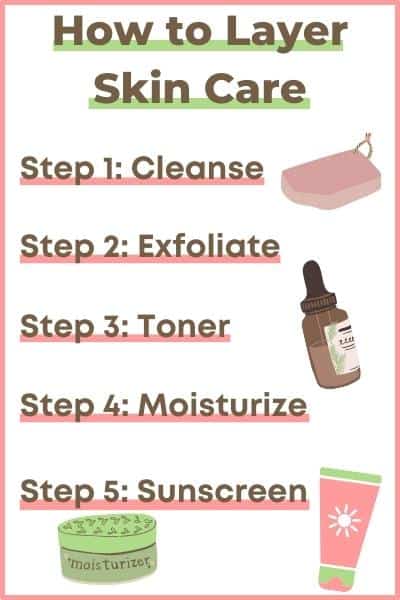
Before You Start: Determine Your Skin Type
Before you get a skin care routine for beginners going, you need to determine what kind of skin you have so you can tailor your routine to your skin’s needs. Everybody has a skin type! So take a look at your skin in the mirror and ask yourself some questions.
Does my face get shiny very quickly? Or does it often feel dry and flaky? Do I get an oily T-zone and then a dry forehead and cheeks?
Now that you’re a little more familiar with how your skin behaves, let’s give it a name and find you a routine. Don’t worry if you feel like you don’t quite match up to a skin type.
That just means you have combination skin. You don’t have to fit the description perfectly. But it does mean that your routine might take a bit more tweaking.
- Dry skin—Often feels tight and flaky with little to no signs of oil
- Oily skin—Face gets shiny quickly, concentrated but not limited to your T-zone
- Combination skin—Oily T-zone with dry/flaky cheeks and chin
For me, I have always had a very oily T-zone and chin area, while my cheeks never seemed to have any issues. Because I would get shiny so fast, I knew pretty quickly in my teenage years that I had oily skin.
Genetics can also play a role in your skin type. Most of my family are pretty oily people, so I wasn’t surprised that I had an oily complexion as well.
Combination skin is one of the most common skin types, so if you’re unsure, you likely have combination skin because you can’t put yourself in a single box.
But don’t worry! Combination skin is one of the easiest skin types to build a routine for. And you have more room for experimentation!
As you start to incorporate products into your new routine, try to get products with your skin type in mind. But don’t panic yet, we’ll go over some ideas for your skin type in a bit. But first, let’s start with some basic skin care routine steps!
Step One: Cleanse
This is probably the most self-explanatory of the steps, but it goes without saying. You need to start out by getting rid of all that grease and grime from the day or previous night!
I don’t wash my face twice a day every day, I just go by what I feel like my face needs at that time. I typically only wash my face in the morning. Unless I put on makeup, then I wash my face at night too.
You also have the option to use an oil or water-based cleanser, based on what you like or your individual skin type. I like water-based cleansers because they’re a little more low-maintenance.
This cleanser by Cocokind is one of my current favorites!
Even if you use an oil cleanser, you will wipe it away with water, which means that it’s okay to use it as your first step. I know that oil cleansers sound a bit counterintuitive, but they’re amazing for certain skin types that we’ll get into in a minute.
Step Two: Exfoliate
This is a step that you shouldn’t do every day. Instead, you should do it two to three times a week, or even every four days if you can get away with it.
You can get an exfoliator as its own product, or combine this step with another one! You can get an exfoliating cleanser to use every couple of days or so, or try an exfoliating scub that leaves your skin feeling moisturized after.
I’ll alternate between the Cocokind cleanser I mentioned earlier and this lovely charcoal facial scrub by Acure. Both of these cleansers are considered great options for affordable natural skin care.
When it comes to using these cleansers, I go by what my skin needs at any given point in time. If I washed my face the night before, then I’ll just spray my face with some rosewater and call it good.
But if I need to wash, then I’ll use either a basic cleanser or a facial scrub, depending on which one I used last or how my skin feels that day. It’s all about asking your skin what it needs!
Step Three: Toner
Speaking of rosewater, it’s one of my absolute favorite toners! And the best part is that it’s super cheap and lasts you well over a year.
Toner tends to get a bad rap for not doing much to your skin, but it’s so incredibly important!
A basic toner can be witch hazel, apple cider vinegar, or rosewater. Each one is designed to help even your skin tone, control excess oil, and provide that much-needed water for moisture.
Your toner also preps your skin for a good moisturizer application. You should apply your moisturizer while your face is still damp from the toner.
That way, you lock all that extra water into your skin’s barrier before it evaporates off of your face.
An absolute staple of my skin care routine involves dampening my face with some lovely rosewater spray, then I’ll immediately apply a moisturizer or serum and my skin feels like a dream!
Step Four: Moisturizer/Serum
What’s the difference between these two, you might ask? A moisturizer is what you’ve likely known your whole life.
It’s (usually) a lightweight lotion meant to keep your face protected and full of moisture.
A serum, however, is a more intensive facial treatment that is made strictly of nourishing oils. For the longest time, I thought that serums were meant only for those who were looking to keep their skin young and cost a ton of money.
This isn’t true at all!
You can get a good facial serum for as low as $20! And you shouldn’t skip them either. They give your skin care routine an extra kick with keeping your skin bright and youthful. They’re also great for treating things like wrinkles, acne, and scars.
You can totally do both a moisturizer and a serum if you want, just make sure you apply whichever one is lighter first. This usually turns out to be the moisturizer.
I personally think it’s a bit overkill to do both in one go, so I usually do one or the other. In the morning, I’ll apply a lightweight moisturizer. At nighttime after a bath, I’ll go in with an intensive facial serum to keep the relaxation going.
Step Five: Sunscreen
You can’t forget to protect yourself from your skin’s worst enemy! Sun damage will age you like no other, and it’s also great prevention from skin cancer.
Here’s where you can combine some skin care steps!
Use a moisturizer in the morning that has some SPF in it! It’s a great way to save some money and buy less products. I love Acure’s Seriously Soothing SPF Day Cream. It goes on a little bit like a sunblock but feels very light on my skin.
Otherwise, if you know you’re about to be outside in the stun all day, I would make this its own step. Badger Balm makes some great natural sunscreen options, including some that are made specifically for your face.
The Best Natural Skin Care Routine for Acne-Prone or Oily Skin
My fellow oily-skinned people, I feel your pain! My face has been an oil slick for as long as I can remember.
I’ve also gone through occasional periods of acne-prone skin as well. What I recommend for this skin type might sound crazy, but hear me out.
If you suffer more from acne-prone skin, you should seriously consider switching to an oil cleanser instead of a traditional water-based cleanser.
This cleansing oil from One Love Organics is a perfect example and has done wonders for oily and acne-prone skin!
Oily skin care products may sound a bit counterintuitive, but there’s science behind it! You need oil to dissolve oil. Plus you need all the goodness from the oil to heal and calm your irritated skin that overproduces sebum.
Witch hazel also makes a great toner for oily skin because it helps tame oil production. Really any of the toners I mentioned earlier work great, because they help balance your skin’s pH.
The key with an oily or acne-prone skin type? Use more oil! It’s actually your skin’s way of crying out for more nutrients through oils, so don’t starve it even more with over-stripping cleansers.
Natural Skin Care Routine for Dry Skin
I also recommend an oil cleanser for dry skin types, because you need all the moisture you can get. Using a serum first thing in the morning should also help keep you from feeling like a dessert all day long.
This very affordable facial serum is great for the morning because it has plenty of uplifting essential oils and even coffee oil to brighten up your skin! I talk about it in more detail in my affordable skin care article.
I also can’t emphasize enough how important it is to apply your moisturizer and/or serum while your face is still damp from your toner!
This will lock in the maximum amount of moisture into your skin, and you want all the help you can get.
And as a side note, if your skin gets more dry in the winter, I have a whole article devoted to the subject! Here’s how I keep my skin happy in the colder months.
The Absolute Best Routine for Combination Skin
You’ve got pretty much free reign if you fall into this category! This can be both a blessing and a curse.
You may have more options when it comes to combination skin care routine products, but it may take a little bit longer for you to figure out what your skin actually likes.
The most common ailment with combination skin is an oily T-zone with dry cheeks and chin. So the trick with that is to find products that are on the lighter-feeling end of the spectrum while still providing moisture to the dryer areas of your face.
You can get away with using a regular water-based cleanser most of the time, but I would consider using an oil cleanser at least two to three times a week. An oil cleanser is beneficial to any skin type!
You might also want to experiment with different levels of moisturizers as the seasons change and your skin’s needs change. Like using a lightweight sunscreen in the summer. It all depends on what makes your skin happy.
Before You Go!
Whatever skin type you have, I hope that this gave you some inspiration to start an all-natural skin care routine for beginners! You’ll be doing your health a major favor in the long run.
If you need some more product inspiration, check out my article on the most affordable natural skin care products.
They’re seriously the best of the best! And they don’t have an outrageous price tag. Click here to read the article!
Related to All-Natural Skin Care:
- EWG Healthy Living App Review | The Best Clean Beauty Tool!
- Do We Really Need Natural Preservatives in Skin Care?
- Save the Planet and Your Wallet with These Cheap Sustainable Beauty Swaps
- How to Start Your Clean Beauty Journey Without Losing Your Mind
- 5 Things No One Will Tell You About the Clean Beauty Community


